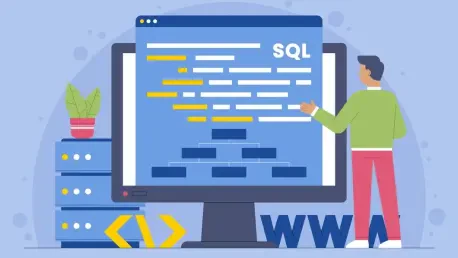Imagine a tech landscape where data drives every decision, yet the tool at the heart of managing this data—Structured Query Language (SQL)—is increasingly called into question. With data volumes skyrocketing and modern applications demanding real-time processing, many in the industry are asking if SQL, a language born in the 1970s, can still keep up. This roundup gathers diverse perspectives from developers, database administrators, and tech analysts to explore whether SQL remains a reliable cornerstone or if it’s time to pivot toward newer alternatives. The purpose is to distill varied opinions, compare contrasting views, and provide clarity on a debate shaping the future of data management.
The Historical Backbone Under Scrutiny
SQL has long been the go-to language for relational database management, structuring data into tables and enabling precise queries across industries. Many experts acknowledge its foundational role in building robust systems, from banking to e-commerce. A consensus exists among seasoned professionals that SQL’s standardized approach offers a level of reliability and familiarity unmatched by many newer tools, making it a default choice for countless organizations.
Yet, beneath this legacy lies growing unease. Industry voices point out that the relational model, while elegant for structured data, often stumbles when faced with today’s sprawling datasets and complex requirements. Analysts highlight that as data diversity expands, SQL’s once-revolutionary design is being tested in ways its creators never anticipated. This tension sets the stage for a deeper dive into specific criticisms and defenses.
Scalability Challenges in a Big Data Era
Performance Bottlenecks at Scale
A recurring critique from database engineers centers on SQL’s struggle to scale with massive data volumes. Many note that operations like JOINs become computationally expensive as datasets grow into petabytes, creating bottlenecks that slow down critical processes. Cloud architects, in particular, argue that sharding—splitting data across multiple servers—introduces layers of complexity that often outweigh the benefits when using traditional SQL systems.
On the other hand, some defenders suggest that scalability issues are not inherent to SQL itself but rather to specific implementations or poor optimization practices. They point to advancements in distributed SQL engines as evidence that the language can adapt to big data demands. This divide reveals a key contention: whether SQL’s core design limits its potential or if better tooling can bridge the gap.
Adapting to Cloud and Distributed Systems
Feedback from cloud computing specialists underscores SQL’s awkward fit with distributed architectures. Many express frustration over the overhead of maintaining consistency across nodes when using relational databases, a problem less pronounced in NoSQL alternatives. This perspective paints SQL as a relic struggling to align with the decentralized nature of modern cloud environments.
Contrarily, a smaller group of experts argues that hybrid solutions, blending SQL with distributed frameworks, offer a viable path forward. They cite examples of systems that retain SQL’s querying power while leveraging cloud-native scalability. This debate highlights a broader question of whether adaptation can save SQL or if its foundational constraints are too rigid for such environments.
Compatibility with Modern Data Formats
Struggles with Non-Relational Data
A significant point of contention among developers is SQL’s compatibility with emerging data formats like JSON and graph structures. Front-end developers working on web applications often lament the clunky workarounds needed to store and query such data in relational tables, describing the process as inefficient and error-prone. They argue that specialized databases handle these formats more intuitively, reducing development time.
Database designers, however, offer a counterpoint, noting that many SQL-based systems have introduced native support for JSON and other formats in recent years. They contend that while not perfect, these updates mitigate the need to abandon SQL entirely for niche tools. This split in opinion underscores a critical balance between innovation within SQL and the allure of purpose-built alternatives.
Real-Time and Streaming Data Demands
Another area of concern comes from data scientists focused on real-time analytics, who argue that SQL falls short in processing streaming data. They describe scenarios where traditional batch-processing models inherent to many SQL systems fail to deliver the immediacy required for applications like fraud detection. This limitation pushes some to advocate for event-driven architectures over relational setups.
In contrast, a faction of tech consultants believes that SQL can still play a role in real-time contexts when paired with complementary technologies like stream-processing frameworks. They suggest that dismissing SQL outright ignores its potential in hybrid setups. This disagreement reflects a wider uncertainty about whether SQL must evolve or be sidelined for cutting-edge use cases.
Usability and Security Concerns
Syntax Complexity and Learning Curve
User experience remains a hot topic, with many junior developers and non-technical stakeholders voicing frustration over SQL’s steep learning curve. They point to its fragile syntax, prone to errors, and the confusion caused by inconsistent implementations across platforms like MySQL and PostgreSQL. This feedback often frames SQL as less accessible compared to modern query languages with simpler designs.
Veteran programmers, however, defend SQL’s complexity as a trade-off for its precision and control over data manipulation. They argue that with proper training, the learning curve flattens, and the language’s depth becomes an asset. This clash of views reveals a divide between accessibility demands and the value of SQL’s detailed functionality.
Persistent Security Vulnerabilities
Cybersecurity experts frequently highlight SQL’s vulnerability to injection attacks as a major flaw, noting that its permissive handling of user input remains a top exploit vector. They stress that despite patches and best practices, the risk persists, especially in legacy systems where security is often an afterthought. This concern fuels calls for inherently safer alternatives.
On the flip side, some security analysts argue that SQL’s vulnerabilities are manageable with rigorous coding standards and modern protective tools. They emphasize that the issue lies more with developer practices than the language itself, advocating for education over replacement. This perspective adds nuance to the discussion, questioning whether SQL’s risks are overstated or truly systemic.
The Rise of Competing Alternatives
Flexibility of NoSQL and Beyond
A growing chorus of tech innovators champions alternatives like MongoDB’s query language and GraphQL, praising their flexibility for modern applications. Web developers, in particular, appreciate how these tools align with dynamic data structures and simplify integration in fast-paced projects. Their enthusiasm suggests a potential shift away from SQL’s dominance in certain domains.
Traditional database administrators counter that while alternatives excel in specific scenarios, they lack the maturity and ecosystem support of SQL. They caution against abandoning a proven system for trendy options that may not withstand long-term demands. This opposition illustrates a broader tension between innovation and stability in data management choices.
Developer Preferences and Market Trends
Insights from industry surveys reveal a noticeable trend: younger developers often gravitate toward NoSQL solutions, valuing readability and ease of use over SQL’s structured rigor. Analysts interpret this as a generational shift, predicting that as these professionals rise in influence, market preferences could tilt further away from relational models. This observation sparks curiosity about the long-term trajectory of database technologies.
Yet, corporate IT leaders stress that SQL’s entrenched position in enterprise systems ensures its relevance for years to come. They argue that the cost of migrating legacy infrastructure often outweighs the benefits of newer tools, favoring incremental updates instead. This pragmatic stance contrasts sharply with the progressive push for wholesale change, highlighting a complex landscape of priorities.
Wrapping Up the Debate
Looking back, this exploration of SQL’s relevance unearthed a spectrum of opinions that painted a nuanced picture of its standing in the tech world. Discussions revealed deep concerns over scalability, compatibility, usability, and security, balanced by staunch defenses of SQL’s reliability and adaptability. The clash between embracing cutting-edge alternatives and refining a time-tested tool emerged as a central theme across varied perspectives.
Moving forward, the tech community might consider hybrid approaches that combine SQL’s strengths with the agility of newer systems as a practical next step. Exploring training programs to bridge usability gaps and investing in security best practices could also mitigate some of SQL’s shortcomings. For those intrigued by this ongoing debate, delving into resources on database trends and emerging query languages offers a valuable avenue to stay informed and prepared for evolving data challenges.








